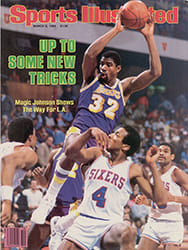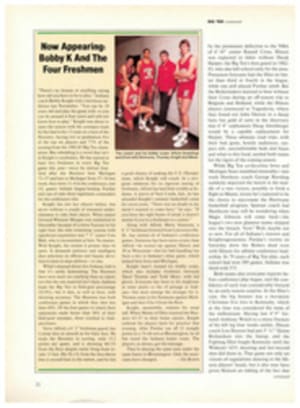
SCORECARD
THE GREAT AMERICAN NON SEQUITUR
It was just a year ago that the New Jersey Generals enticed Herschel Walker out of the University of Georgia in what the USFL called an "exception" to its rule against signing players who hadn't used up their college eligibility. Today that rule and a longer-standing NFL prohibition against trafficking in still-eligible collegians are under assault on several fronts. In U.S. District Court in Los Angeles, Bob Boris, a former University of Arizona punter who left school without graduating, has brought an antitrust suit against the USFL in which he argues that the league's rule deprived him of a chance to play for USFL teams; in late January, Judge Lauglin E. Waters ruled in favor of Boris on that point, a decision that, if it stands, presumably would be the death knell for the USFL rule. The USFL has indicated it will appeal, but it has meanwhile allowed Boris to sign this season with the Oklahoma Outlaws. In U.S. District Court in Chicago, former University of Illinois defensive lineman Ken Durrell has brought a similar suit challenging the rules of both the USFL and NFL prohibiting the signing of underclassmen. And the Federal Trade Commission is investigating whether those rules violate antitrust law.
It's hard to wish the NFL and USFL well in any of these cases. In refusing to traffic in collegians before their classes have graduated, the pro leagues are doing the bidding of college coaches who argue that the signing of such players would 1) severely damage intercollegiate football and 2) interfere with players' educations. Both arguments are specious. The early loss of some stars is unlikely to diminish the esprit that gives college football much of its appeal; an NBA ban against signing undergraduates with eligibility remaining was struck down in an antitrust suit brought by Spencer Haywood in 1971, and college basketball has since enjoyed enormous growth in popularity. The academic argument is even less persuasive; even with the NFL's hands-off-underclassmen policy, barely one-third of its players have college degrees.
Far from harming the colleges, doing away with the rules in question would have the welcome effect of eliminating the demeaning—to all concerned—situation in which colleges conspire to hold their players in something resembling bondage. One thinks here of Marcus Dupree, who has dropped out of two colleges in this, his sophomore year, and who, it has become increasingly clear, isn't much interested in pursuing a college education. Last weekend the USFL's New Orleans Breakers said they were negotiating with Dupree, but the league office was holding to the official line that he was off-limits. If the NFL and USFL eligibility rules remain in force, Dupree wouldn't be able to play pro football until 1987. Moreover, because of the NCAA's equally restrictive rules governing transfers, he's also currently ineligible to play college football. Boris and Durrell found themselves in a similar no-man's-land. Both were ineligible in college because of academic difficulties, yet were blocked from playing in the NFL or USFL because of the ban against signing underclassmen.
The ironic thing about the rules prohibiting football players from bolting to join the pros is that some of those athletes probably shouldn't have been in college to begin with, a fact underscored by the academic-transcript and other admissions-related scandals of recent years. In going to inordinate lengths to attract and then hang on to outstanding athletes, colleges are exacerbating a situation that Duke law professor John C. Weistart characterizes in a recent issue of the Journal of College and University Law as The Great American Non Sequitur. Lamenting the fact that so much of high-level sports competition in the U.S. is rooted in universities, Weistart writes: "We have, in this country, embraced the not-wholly-logical notion that if a young man exhibits certain unusual physical skills and wants to secure refinement of his talent, he must also be both motivated and qualified to go to college." Weistart bleakly concludes that in the absence of other post-high school outlets for talented athletes who can't cut it in the classroom, college sports will inevitably continue to be riddled by academic abuses.
The case is strong, in other words, for expanding the options for college-age athletes. The NFL and USFL rules unjustifiably limit those options.
HIGH-LOW GAME
On Jan. 24 Boone County High beat Newport High 117-111 in what went into the books as the highest-scoring game in the history of Kentucky schoolboy basketball. In running up all those points, however, the teams had help from a malfunctioning clock. High school games last 32 minutes, and at the end of the first half, which apparently ran the normal 16 minutes, the score was only 35-35. But the points began to pile up in the second half, and it wasn't until late in the game that officials figured out the reason: The clock had been taking several extra seconds to restart after every interruption of play. Unable to correct the malfunction, the coaches simply let the game drag on to its record-setting conclusion.
Is it fair to credit two teams with the record for most points in regulation time when their game lasted longer than regulation time? That question is now purely academic. After discovering that one of its players was ineligible, Boone County has had to forfeit five of this season's victories, including the one over Newport. This makes the score 1-0, equaling the lowest-scoring game in Kentucky high school history.
MOOD MUSIC
When a fight broke out Saturday during the Canadiens' 7-4 win over the New York Rangers, the organist at the Montreal Forum began playing Eye of the Tiger, the theme song from Rocky III. Tempers continued to flare, the officials had trouble restoring order and two players were ejected. Two days earlier a fight had commenced at Madison Square Garden during the Rangers' 4-2 defeat of the Quebec Nordiques, but it quickly petered out. The organist's selection during that one was You Always Hurt the One You Love.
A CLASSIC
The award for the smelliest trade of the week goes to David Schoenstadt, who owns both the New York Arrows and the Kansas City Comets in the Major Indoor Soccer League. The MISL is freewheeling enough both to allow such dual ownership and to have looked the other way when the Eastern Division also-ran Arrows traded star forward Njego Pesa to the St. Louis Steamers, a team that was in a fierce battle with Schoenstadt's Comets for first place in the Western Division.
Would baseball allow George Steinbrenner to own both the Yankees and the White Sox? Even if it did, would it then think nothing of it if George shipped Dave Winfield to the Royals when the latter team was challenging the Sox for first place? Of course not. Schoenstadt lamely explained that last week's confounding deal was made "for the good of the Arrows"—the New York team received a draft choice and a reported $7,500 in exchange for Pesa—and he further insisted that the Comets could "overcome" Pesa's presence in the St. Louis lineup. But he also had the grace to admit that the trade was "a classic example of conflict of interest."
DEATH OF A LATE BLOOMER
The Los Angeles Rams' Kirk Collins, who had come into his own as a corner-back in 1983, died last week at the age of 25 of cancer of the esophagus, a rare disease in one so young. At Sam Houston High School in San Antonio, Collins came so late to the game that he wasn't recruited by any four-year university and wound up instead at Binn (Texas) Junior College. Although he eventually won a scholarship to Baylor, he didn't start for the Bears until the final game of his junior year and was selected by the Rams only in the seventh round of the 1980 college draft. Collins made the team but spent his first season on injured reserve and his next two on special teams and as a reserve safety. But Collins was quick and smart and never stopped improving, and last fall he not only became a starter but also was leading the NFL in interceptions early in the season. He appeared to be emerging as a star.
But then tragedy struck. In the first quarter of a 27-24 overtime loss to the Jets on Sept. 25, Collins pulled a groin muscle while returning an interception 58 yards, his second interception of the day and fifth of a season then only four weeks old. He would never play football again. In an examination prompted by the groin injury, a malignant tumor was discovered in his throat. After that Collins attended Rams practices in street clothes and accompanied the team to some away games. He was awarded the game ball after the Rams' 24-17 upset of Dallas in the playoffs, a game he watched on TV from a hospital bed. His death came less than five months after his final NFL game.
THE MAHRES' PREDECESSORS
Phil and Steve Mahre were the first brothers to finish one-two in the same event in the Winter Olympics, but they weren't the first siblings to do so. In fact, the Goitschels of France did it twice in 1964 in Innsbruck, Christine finishing ahead of Marielle in the slalom and Marielle winning the giant slalom while Christine tied for the silver with Jean Saubert of the U.S. And brothers have gone one-two at the Summer Games. In 1896 John and Sumner Paine of the U.S. won the gold and silver medals in the military pistol event in the first modern Olympics in Athens, and two other Americans, Piatt and Ben Adams, did likewise in the standing high jump in 1912. In 1952 fencers Edoardo and Dario Mangiarotti of Italy went one-two in the épée. Raimondo and Piero D'Inzeo, also of Italy, took the gold and silver in individual show jumping at the 1960 Summer Games, but their horses weren't related.
SIMILARITY OF SORTS
What came to your mind when you saw the symbol of the 1984 Winter Olympics? Most people doubtless interpreted the symbol as being a stylized snowflake. Gary Griffin, a chemistry professor at the University of New Orleans, and Laurence Peterson, until recently the vice-president of Celanese Research Company, had another view. The ubiquitous design made them think of the symbolic representation of tetramethy lenecyclobutane, the non-benzoid aromatic hydrocarbon molecule they synthesized when they were professor and student, respectively, at Yale in 1962.
When it comes to geometric design, similarity, like beauty, is apparently very much in the eye of the beholder. "We talked about writing a tongue-in-cheek letter to Sarajevo telling them they had stolen our molecule and we were going to sue them for two suitably framed posters of the logo," Griffin says. It's probably just as well that he and Peterson finally settled for the satisfaction of seeing their molecular symbol, or something roughly like it, get worldwide exposure. Afterall, the word out of Sarajevo is that the Olympic design was the handiwork of the late Miroslav Apronic, a Yugoslav economist and graphic designer who got the idea for it from the pattern in an old handmade rug.
ILLUSTRATION
ILLUSTRATION
Sarajevo's design.
ILLUSTRATION
Molecular symbol.
THEY SAID IT
•Don DeVoe, Tennessee basketball coach, asked about his team's seeming paucity of shooters: "I have plenty of shooters. I just don't have many makers."
•Ken Plutnicki, Harvard forward, describing his frustration after the Crimson came close to beating heavily favored Duke only to lose 89-86: "It's like climbing the highest mountain and finding that the guru at the top doesn't know the meaning of life."

